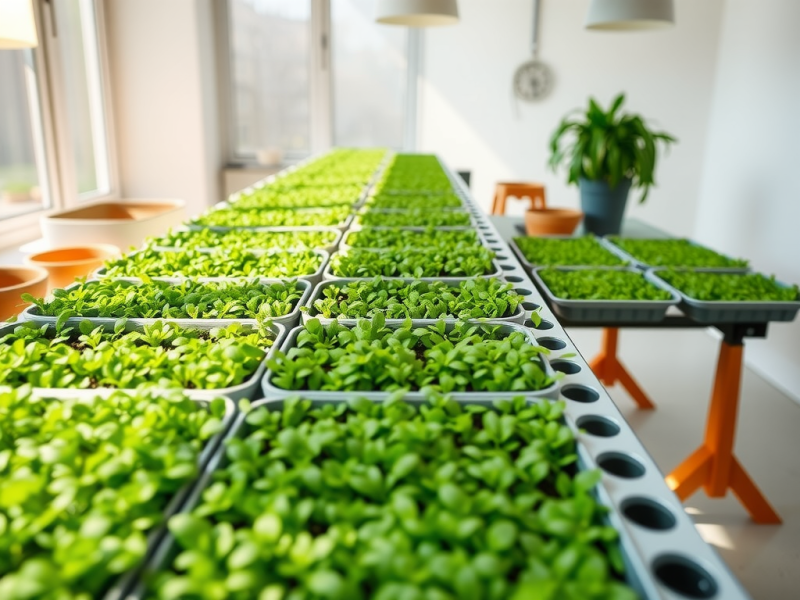
Diving into the microgreens farming business opens a world of opportunities. With the rising trend of health-conscious consumers seeking nutrient-dense produce, your microgreens venture can truly flourish.
First, explore sustainable agriculture approaches; they not only appeal to eco-aware customers but also enhance your brand image.
Next, consider incorporating vertical farming techniques to maximize your yield in limited spaces.
Innovative marketing strategies, like social media engagement and sharing health benefits, can significantly boost visibility.
Establishing connections with local food markets creates valuable partnerships that bring your vibrant successfully/” title=”How To Grow Microgreens Indoors Successfully”>microgreens directly to eager consumers. With a solid business plan in place, you’re setting up for success!
Click here to learn more about: microgreens business plan template
Identifying Niche Markets For Microgreens
Navigating the market demands makes all the difference in your microgreens success.
Consider how health-conscious consumers are influencing preferences for specific varieties. Conducting market research through surveys can highlight trending microgreens, while focus groups reveal their motivations.
Research Techniques
- Surveys: Gather insights on customer preferences and buying behaviors.
- Focus Groups: Delve deep into consumer motivations and desires.
Explore local food markets as a lucrative niche, where businesses seek fresh, organic products to attract clientele. For instance, local restaurants that embrace sustainable cuisine often desire unique microgreens to enhance their dishes. By pinpointing these niche markets, you can tailor your offerings and strengthen your position in the competitive landscape.
“The key to thriving in the microgreens business lies in knowing your audience and continually adapting to their needs. ”
By incorporating culinary applications and focusing on product differentiation, you’ll engage customers more meaningfully. Now, let’s dive into specific market segments that are ripe for exploration!

Effective Marketing Strategies For Growth
Reaching out to health-conscious consumers takes more than just a great product; it demands innovative marketing strategies tailored to the unique offerings of microgreens. Building brand awareness often starts with engaging storytelling and captivating visuals.
Think about how social media platforms like Instagram or TikTok can be utilized to specifically target certain demographics, enhancing consumer engagement and driving sales.
A great example is the successful launch of a microgreens campaign that featured vibrant images and recipe videos showcasing their versatility.
This strategy not only boosted organic sales significantly but also increased customer engagement.
For practical tips, consider creating engaging content that sparks user interaction—like fun challenges or recipe showcases—to foster a community around your brand.
Targeting Specific Demographics
Utilizing social media marketing is essential for targeting specific demographics. By understanding your audience’s preferences on platforms like Instagram, you can craft messages that resonate deeply, thus increasing your reach and connection with potential customers.
Highlighting Health Benefits Of Microgreens
Connecting the dots between microgreens and consumer health trends is key to successful marketing.
Scientific studies highlight that microgreens are indeed nutrient-dense produce, boasting higher concentrations of vitamins than their mature counterparts. This resonates with health-conscious consumers who are constantly seeking nutritious options.
Communicating Health Benefits
To effectively communicate these benefits, incorporating infographics or simple charts in your marketing materials can outline the health claims associated with different microgreens.
This visual approach not only makes the information more digestible but also enhances consumer education, establishing a stronger connection with your target market.
Practical Tip for Marketing
Consider creating promotional materials that emphasize the health benefits of microgreens.
Showcase their use in recipes, culinary applications, or even health-focused meal plans.
Using different formats—like videos, blog posts, and guides—can effectively engage your audience while providing valuable information.
By focusing on innovative marketing strategies and highlighting the health benefits of microgreens, you can not only enhance your brand’s visibility but also cultivate a loyal customer base that appreciates both taste and health.
Microgreens Marketing
- Microgreens are 4 to 40 times more nutrient-dense than their mature counterparts, making them appealing to health-conscious consumers.
- Visual content, such as vibrant images and recipe videos, can increase engagement on social media platforms by up to 94%.
- Infographics are shared 3 times more than other types of content, enhancing consumer education about health benefits.
- Targeted social media marketing can increase brand awareness and customer loyalty by connecting deeply with specific demographics.
Optimizing Yield Through Hydroponic Systems
Looking for a way to boost productivity in small spaces? Hydroponics offers an exciting solution for those interested in sustainable agriculture. It significantly enhances yield while conserving precious resources.
Various hydroponic methods, such as the nutrient film technique (NFT) and deep water culture (DWC), come with their own sets of benefits.
For instance, NFT minimizes water usage while maximizing nutrient absorption, which translates to robust crop growth.
When diving into the world of hydroponic systems, it’s essential to consider factors like available space and the specific plant types you want to grow.
A great tip is to start small—perhaps with a hydroponic microgreens farm right in your home. Not only is this a fantastic way to experiment, but many successful microgreens farms show that hydroponics can transform urban cultivation into a flourishing small-scale business.
“Hydroponics can change your approach to urban farming, bringing innovative methods to local food markets. ”.
Engaging Health-Conscious Consumers Effectively
Connecting with health-conscious consumers involves a tailored approach that resonates with their values and lifestyle choices.
Social media marketing platforms, like Instagram and Facebook, serve as essential channels for showcasing fresh, nutrient-dense produce. Here are some effective strategies:
Effective Marketing Strategies
- Visual Appeal: Use engaging visuals and recipe showcases to draw interest.
- Transparency: Building trust requires transparency about your sourcing methods and highlighting organic certifications.
- Community Collaboration: Successful brands often team up with local chefs for interactive campaigns.
These tactics not only create buzz around your product but also link directly to the growing trend of sustainable agriculture and health-focused lifestyles. Don’t forget to:
Build Trust with Your Audience
Offering detailed information about your farming practices can deepen connections with health-conscious consumers. Also, consider engaging with customers through:
- Farmers’ Markets: Interact directly with potential buyers and showcase your microgreens’ flavor diversity.
- Subscription Boxes: Offer consistent revenue and customer retention.
- Social Media Content: Highlight your microgreens’ versatility in various culinary applications.
“Establishing a brand presence not only boosts visibility but also emphasizes your commitment to eco-friendly practices. ”.
Hydroponics and Marketing
- Hydroponic systems can produce up to 30% more yield compared to traditional soil methods.
- Urban farming initiatives have increased by 50% in the past decade, driven by sustainable practices.
- Health-conscious consumers are willing to pay a premium for locally sourced, organic produce, often up to 20% more.
- Social media marketing can increase brand engagement by 70%, particularly in the food and agriculture sectors.
Building Brand Loyalty In Local Markets
Brand loyalty flourishes through strong connections to local communities. Building relationships with your neighbors fosters trust and creates a sense of belonging that customers truly value.
Engaging with local culture not only enhances brand visibility but also significantly influences consumer choices, as many prefer to support businesses that actively contribute to their area.
Local partnerships are essential in this journey.
Collaborating with nearby restaurants and farmers’ markets boosts your brand’s credibility and expands your reach.
Participating in community events allows you to showcase your microgreens, reinforcing your reputation as a beloved local staple. To deepen customer loyalty, think about implementing loyalty programs that resonate with community values—like a “Buy 10, Get 1 Free” initiative.
Sweetgreen exemplifies how a brand can effectively cultivate local loyalty by prioritizing local sourcing and partnerships.
Exploring Culinary Applications For Microgreens
Microgreens are quickly becoming a staple in the culinary world thanks to their flavor and impressive health benefits. Many health-conscious consumers actively seek out nutrient-dense foods, making these tiny greens a popular choice on trendy menus.
Chefs can creatively integrate microgreens into various dishes, whether in salads, as garnishes, or mixed into sauces, enhancing both visual appeal and flavor.
Creative Integration of Microgreens
A practical tip for home cooks is to sprinkle microgreens over soups or sandwiches for an instant burst of flavor.
Experimenting with various plant varieties, such as mustards or beets, can infuse exciting tastes into everyday meals.
Chefs like Thomas Keller showcase these versatile greens, demonstrating their ability to elevate dishes and inspire culinary creativity.
Maximizing the Potential of Microgreens
To thrive in the microgreens business, aspiring entrepreneurs should focus on indoor or vertical farming techniques. These methods maximize yield, even in limited spaces, aligning with a growing demand for sustainable agriculture practices.
Crafting a solid business plan that includes goals, marketing strategies, and financial projections is essential for success.
Building collaborations with local restaurants and health food stores, along with participating in farmers markets, strengthens community ties. This approach not only increases visibility but also positions your brand as a preferred source for fresh, organic microgreens.
To solidify your offering, consider subscription models for consistent revenue and customer retention.
Microgreens and Brand Loyalty
- Studies show that 70% of consumers prefer to buy from brands that support local communities.
- Microgreens can contain up to 40 times more nutrients than their mature counterparts, making them highly sought after by health-conscious consumers.
- Businesses that implement loyalty programs can see a 20% increase in repeat customers.
- Vertical farming can yield up to 10 times more produce per square foot compared to traditional farming methods.
Implementing Sustainable Agriculture Practices
Embracing sustainable agriculture can really elevate your microgreens farming journey. These practices enhance productivity and resonate with health-conscious consumers looking for nutrient-dense produce.
One effective method is vertical farming, ideal for optimizing space in urban cultivation.
It allows you to make the most of your resources while providing fresh greens year-round.
Hydroponic systems serve as another fantastic choice, enabling you to grow vibrant microgreens with a minimal environmental footprint.
As you adopt sustainable methods, why not start small? Consider switching to organic farming methods or exploring biodegradable packaging solutions. These changes not only benefit the environment but also appeal to consumers who prioritize sustainability in their purchasing decisions.
For some inspiring success, take a look at XYZ Farms, a shining example of a microgreens business that has seamlessly integrated eco-friendly practices. They’ve attracted a loyal customer base and seen impressive sales growth by promoting local food markets and emphasizing food sustainability.
Eco-Friendly Practices
Making the shift towards eco-friendly practices can seem daunting, but it’s all about taking manageable steps.
Start by getting familiar with crop rotation techniques to maintain soil health, ensuring your microgreens thrive.
Highlighting the health benefits of microgreens can be a game changer in your marketing strategy.
Customers are often eager to learn about the health benefits associated with these tiny greens.
When planning your microgreens business, think about optimizing your operations through smart business planning and financial forecasting. Building relationships with local businesses, such as restaurants and farmers’ markets, can enhance your visibility and sales.
Consider offering subscription models or seasonal produce delivery to keep your clientele engaged and satisfied.
Engaging with your community through food service partnerships can help establish your brand while fostering a sustainable network.
Sustainable Agriculture Practices
- Vertical farming can increase crop yield by up to 10 times compared to traditional farming methods.
- Hydroponic systems use up to 90% less water than conventional soil-based farming.
- Organic farming methods can improve soil health and biodiversity, leading to more resilient ecosystems.
- Subscription models can create a steady revenue stream, with studies showing a 30% increase in customer retention for businesses that offer them.




